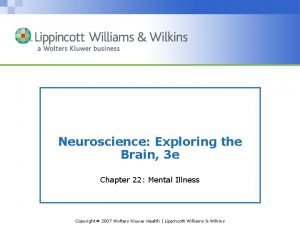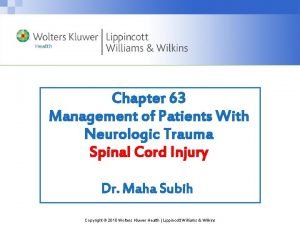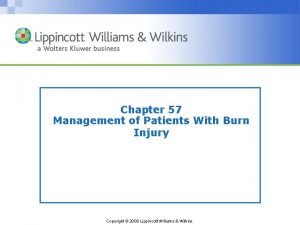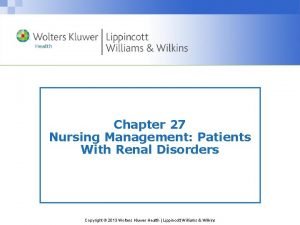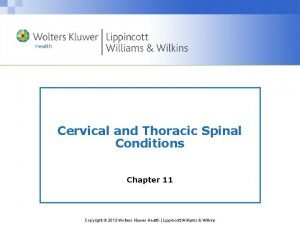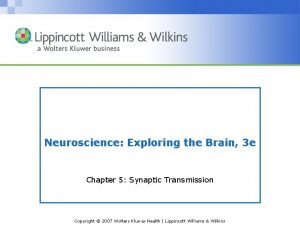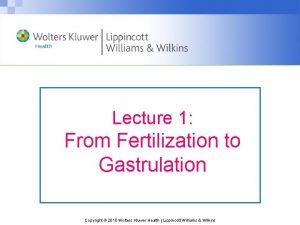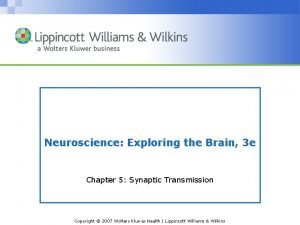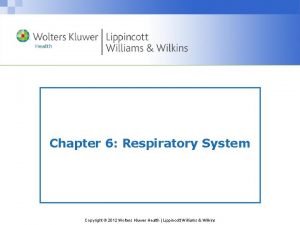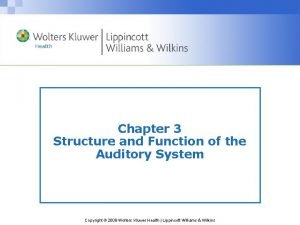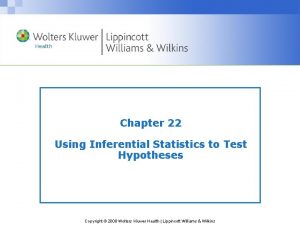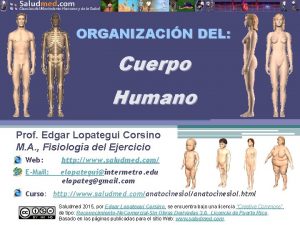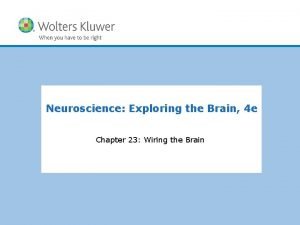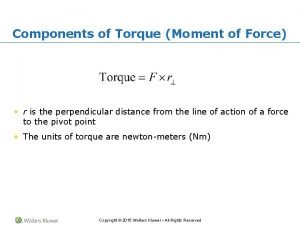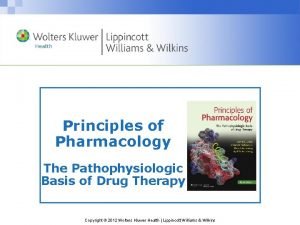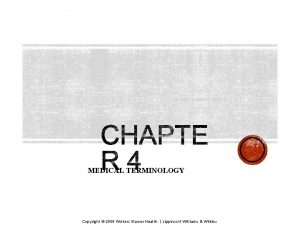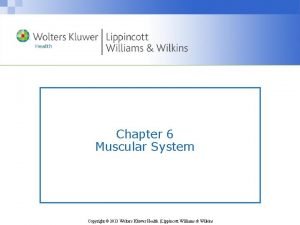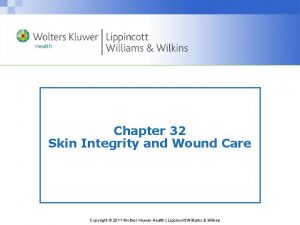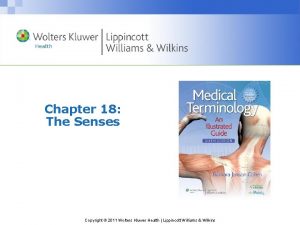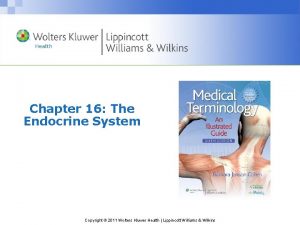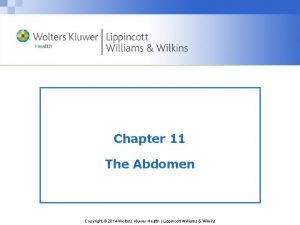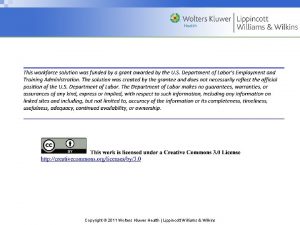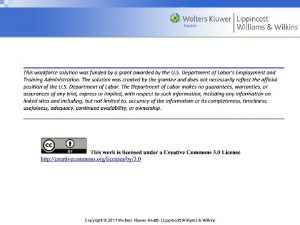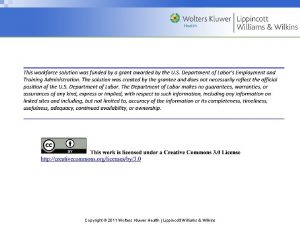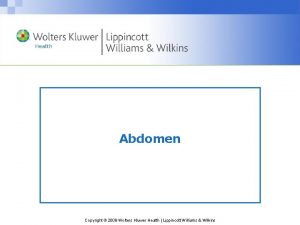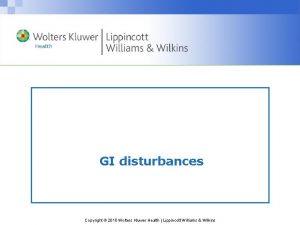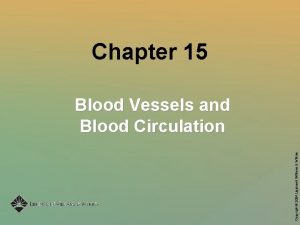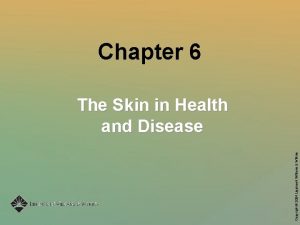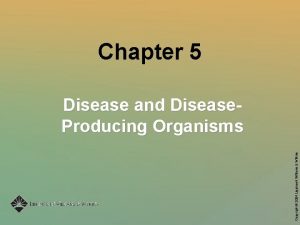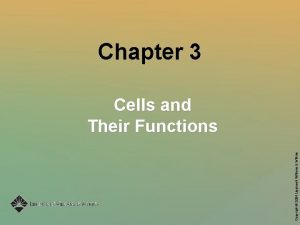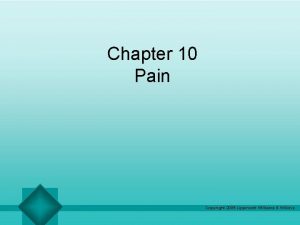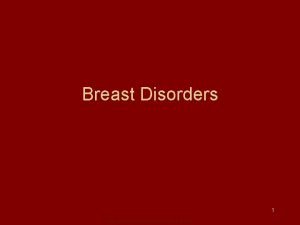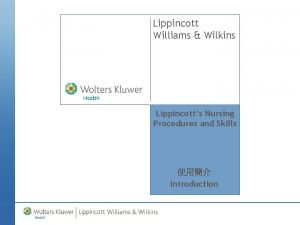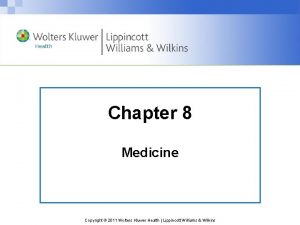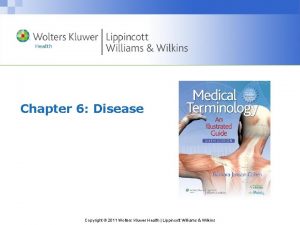Copyright 2011 Wolters Kluwer Health Lippincott Williams Wilkins



























- Slides: 27

Copyright © 2011 Wolters Kluwer Health | Lippincott Williams & Wilkins

Chapter 19 Disorders and Issues of Older Adults Copyright © 2011 Wolters Kluwer Health | Lippincott Williams & Wilkins

Aging Defined • Aging a manifestation of changes that advance in a continuous and progressive manner during the adult years – Graying hair, presbyopia, wrinkling • Primary aging result of genetics of natural factors • Secondary aging influenced by environment • Losses that occur more frequently among the older adult population include loss of: health, retirement, income, status, independence Copyright © 2011 Wolters Kluwer Health | Lippincott Williams & Wilkins

Psychosocial Issues • Ageism – Commonly held belief that stereotypes and minimizes the worth of the aging person by indicating that senescence and mental health conditions are a part of the normal process – Minimizes worth of aging person – Promotes assumption that older people are incompetent and inferior Copyright © 2011 Wolters Kluwer Health | Lippincott Williams & Wilkins

Impaired Cognitive Functioning • Some measure of deterioration in a person’s ability to perform activities of daily living • More defined than normal aging process • Centered on memory loss • State of confusion, unable to understand present experiences Copyright © 2011 Wolters Kluwer Health | Lippincott Williams & Wilkins

Types of Cognitive Disorders • Delirium • Dementia • Amnestic disorders Copyright © 2011 Wolters Kluwer Health | Lippincott Williams & Wilkins

Delirium • Disturbance of consciousness and change in cognition developing over short period – Decreased awareness – Inability to focus – Disorientation – Memory loss – Language disturbance – Perceptual alterations Copyright © 2011 Wolters Kluwer Health | Lippincott Williams & Wilkins

Delirium Signs and Symptoms - Rapid onset - Fluctuating course - Intermittent memory loss - Globally reduced attention span - Poorly organized thoughts/incoherent speech - Psychomotor activity change - Tremors - Appetite and sleep disturbances Copyright © 2011 Wolters Kluwer Health | Lippincott Williams & Wilkins

Causes of Delirium • Medical conditions • Medications • Substance toxicity • Toxin exposure • Combination of factors • Older adults at greater risk multiple diagnoses and multiple medications, decreased metabolism and excretion of drugs Copyright © 2011 Wolters Kluwer Health | Lippincott Williams & Wilkins

Dementia • Irreversible, progressive cognitive decline including loss of awareness, judgment, ability to reason • Severe enough to interfere with daily functioning and communication with others – Alzheimer’s Dementia – Vascular Dementia – Lewy body dementia Copyright © 2011 Wolters Kluwer Health | Lippincott Williams & Wilkins

Alzheimer’s Dementia • Primarily affects – Cerebral cortex (conscious thoughts and language) – Production of acetylcholine (memory and learning) – Hippocampus (memory storage) – Neurons degenerate and lose synaptic connections to other neurons (unable to make thought-memory connections) Copyright © 2011 Wolters Kluwer Health | Lippincott Williams & Wilkins

Alzheimer’s Signs and Symptoms • Losses – Ability to do purposeful movement (apraxia) – Encoding information for recall – Early stages may be aware of memory deficit and use confabulation (fictitious statements) – Ability to acquire and process new information – Recent memory lost first – Remote memory as disease progresses Copyright © 2011 Wolters Kluwer Health | Lippincott Williams & Wilkins

Alzheimer’s Language Problems • Anomia inability to find the right word • Agnosia inability to identify an object • Aphasia impairment in the significance or meaning of language • Clinical Stages of Alzheimer’s Disease Table 19. 2 Pg. 304 Copyright © 2011 Wolters Kluwer Health | Lippincott Williams & Wilkins

Other Alzheimer’s Disease Symptoms • Catastrophic events verbal or physical agitation in response to frustration and perceived threat/fear of environment • Resistance to care • Perceptual alterations • Hide things suspicious of others • Restlessness, pacing, wandering • Interruption of sleep-wake cycle • Sundowning Copyright © 2011 Wolters Kluwer Health | Lippincott Williams & Wilkins

Vascular Dementia • 2 nd most common cause of dementia • Caused by effects of one or more strokes on cognitive functioning – Characterized by an abrupt onset and follows a step-like pattern of cerebrovascular disease and symptoms • Early stages personality and insight better preserved than in Alzheimer’s disease • Depression common • Neurologic symptoms • Cognitive deficits • Less common than Alzheimer’s disease • Signs and Symptoms of Vascular Dementia Box 19. 7 Copyright © 2011 Wolters Kluwer Health | Lippincott Williams & Wilkins Page 305

Lewy Body Dementia • Deposits of proteins (Lewy bodies) develop in the brain – Only one portion of the brain • Similar symptoms to those of Alzheimer’s • Also hallucinations of colors, people, or animals • Paranoia • Delusional thinking • Parkinson-like symptoms • Mental alertness intermittent • Average life span after dx is 6 -8 years Copyright © 2011 Wolters Kluwer Health | Lippincott Williams & Wilkins

Depression and Dementia • Depression is the most common mental disorder in the older adult population • Nonprogressive • May accompany early stages of dementia • Changes in appetite, sleep patterns • Fatigue • Withdrawal, self-neglect, helplessness • Will not attempt to answer questions • Responds to treatment improvement in cognitive Copyright © 2011 Wolters Kluwer Health | Lippincott Williams & Wilkins ability

Amnestic Disorders • Cognitive disorders characterized by a disturbance in memory • Occur as result of – Trauma – Surgery – Hypoxia – Other pathologic condition affecting the brain • No impairment in abstract thinking or judgment • Signs and Symptoms of Amnestic Dx Box 19. 9 Page 307 Copyright © 2011 Wolters Kluwer Health | Lippincott Williams & Wilkins

Treatment of Mental Disorders in Older Adults • No cure for Alzheimer’s or Lewy body dementia • Management aimed at controlling cognitive/behavioral symptoms • Medications – cholinesterase inhibitors – Increases the levels of neurotransmitters or chemical messengers to the portions of the brain affected by AD • Most effective combination of antidepressant medication and psychotherapeutic approaches Copyright © 2011 Wolters Kluwer Health | Lippincott Williams & Wilkins

Nursing Process Applied Delirium • Assessment Page 308 -309 – Determine cause of disorientation • Nursing diagnoses • Expected outcomes • Nursing interventions • Evaluation – Reversal of underlying problem Copyright © 2011 Wolters Kluwer Health | Lippincott Williams & Wilkins

Nursing Process Applied Dementia • Assessment Page 309 -313 • Nursing diagnoses • Expected outcomes • Nursing interventions – Catastrophic events: redirect and distract • Demented person is unable to control behavior intervene and prevent injury to client or others • Who-what-when-where-why • Evaluation Copyright © 2011 Wolters Kluwer Health | Lippincott Williams & Wilkins

Question • Which of the following disorders is characterized by a disturbance of consciousness and a change in cognition that develop over a short time? A. Delirium B. Amnestic disorder C. Alzheimer’s dementia D. Vascular dementia Copyright © 2011 Wolters Kluwer Health | Lippincott Williams & Wilkins

Answer • A. Delirium • Rationale: There are many different causes for delirium in older adults, but a person with delirium presents with a disturbance in his or her level of awareness and cognitive functioning. Copyright © 2011 Wolters Kluwer Health | Lippincott Williams & Wilkins

Question • Sundowning syndrome is A. Inability to find the right words B. Impairment in the significance or meaning of language C. Filling in gaps with fictitious statements D. Peak period of agitation and acting out behavior Copyright © 2011 Wolters Kluwer Health | Lippincott Williams & Wilkins

Answer • D. Peak period of agitation and acting out behavior • Rationale: Sundowning syndrome is associated with Alzheimer’s dementia. Behavior problems arise out of the fear and confusion that comes as the person attempts to cope with stimuli that he or she does not understand. Copyright © 2011 Wolters Kluwer Health | Lippincott Williams & Wilkins

Question • Tell whether the following statement is true or false. A client with either depression or dementia will attempt to answer questions, but his or her answer might not make sense. Copyright © 2011 Wolters Kluwer Health | Lippincott Williams & Wilkins

Answer • False • Rationale: One of the distinguishing factors between dementia and depression is that a depressed person will usually answer questions with “I don’t know”, whereas a demented person will attempt to answer. Copyright © 2011 Wolters Kluwer Health | Lippincott Williams & Wilkins
 Wolters kluwer health lippincott williams & wilkins
Wolters kluwer health lippincott williams & wilkins Lippincott williams & wilkins
Lippincott williams & wilkins Lippincott williams & wilkins
Lippincott williams & wilkins 2008
2008 Lippincott williams & wilkins
Lippincott williams & wilkins Lippincott williams & wilkins
Lippincott williams & wilkins Lippincott williams & wilkins
Lippincott williams & wilkins Lippincott williams & wilkins
Lippincott williams & wilkins Lippincott williams & wilkins
Lippincott williams & wilkins Wolters kluwer health
Wolters kluwer health Lippincott
Lippincott Wolters kluwer health
Wolters kluwer health Wolters kluwer health
Wolters kluwer health Wolters kluwer health
Wolters kluwer health Wolters kluwer health
Wolters kluwer health Wolters kluwer health
Wolters kluwer health Wolters kluwer
Wolters kluwer Wolters kluwer
Wolters kluwer Wolters kluwer
Wolters kluwer Wolters kluwer
Wolters kluwer Chapter 25 assessment of cardiovascular function
Chapter 25 assessment of cardiovascular function Wolters kluwer
Wolters kluwer Wolters kluwer pronunciation
Wolters kluwer pronunciation Wolters kluwer
Wolters kluwer Chapter 48 skin integrity and wound care
Chapter 48 skin integrity and wound care Wolters kluwer
Wolters kluwer Wolters kluwer
Wolters kluwer Wolters kluwer
Wolters kluwer

